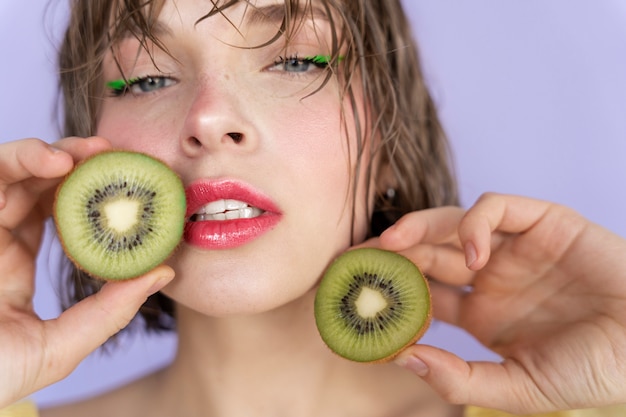Fruit lovers love kiwifruit for its bright color and sweet-tart taste, but its fuzzy brown skin is frequently thrown away. The majority of people automatically peel it off because they believe it to be unappealing or inedible. However, food scientists and nutritionists contend that the skin is safe to consume and has a wealth of amazing health advantages.
So, should you begin eating skin-on kiwis? The short answer is yes, and here’s how making this minor adjustment can improve your nutrition and cut down on food waste.
Why It’s a Good Idea to Eat Kiwi Skin
Even though kiwi flesh is already rich in vitamins and fiber, the fruit’s nutritional value is increased by the skin. For a significant nutritional boost, think about eating the entire fruit rather than peeling it off.
| Health Benefit | Why Kiwi Skin is a Game-Changer |
|---|---|
| Boosts Fiber Intake | Eating a whole kiwi with the skin increases fiber content by 50%, promoting gut health and digestion. |
| Triples Antioxidants | The skin contains three times more antioxidants than the flesh, helping combat cellular damage and aging. |
| Enhances Vitamin E Levels | Keeping the skin on a gold kiwi boosts vitamin E content by 32%, supporting immune function and healthy skin. |
| Adds More Vitamin C | Kiwi skin increases total vitamin C intake, further strengthening immunity and reducing inflammation. |
| Provides Polyphenols | These powerful compounds fight oxidative stress and support heart health. |
The fruit is one of the most nutrient-dense snacks available, and eating the skin amplifies its health benefits.
Which Type of Kiwi Is Ideal for Whole Eating?
Because different kiwis have different skin textures, some are easier to eat whole than others.
Actinidia deliciosa, or green kiwifruit
The fuzzy, fibrous skin of this traditional variety can be a turnoff for some people, despite its bright green flesh and slightly tart flavor. But if you can ignore the texture, it’s just as tasty and nourishing.
Actinidia chinensis, or gold kiwifruit
Gold kiwis are ideal for those who are new to eating kiwi skins because they are sweeter, smoother, and have a slightly tropical flavor. It is much easier to enjoy because of the skin’s thinness, lack of fuzz, and mild texture.
Gold kiwis are an excellent starting point if you’re not comfortable eating kiwi skin.
How to Consume Kiwi Skin Without Getting Bothered by Fuzz
Here are some simple ways to improve the texture of kiwi skin for people who don’t like it:
✔ Give it a good wash: Scrubbing the kiwi under water gets rid of any dirt or pesticide residue.
✔ Rub off the fuzz – The hairy outer layer can be removed with a vegetable brush, a spoon, or a clean towel.
✔ Slice it thin: The texture of the kiwi’s skin is less noticeable when it is cut into thin rounds.
✔ Add it to smoothies: Adding a whole kiwi to a blender gives it extra nutrients and fiber without adding any texture.
These easy tips make eating kiwi skin a healthy and convenient habit.
Does Eating Kiwi Skin Have Any Drawbacks?
Even though kiwi skin is a great source of nutrients, not everyone will benefit from it. Here are some things to consider:
🔹 Texture Sensitivity: On green kiwis in particular, the fuzzy exterior may feel a little rough.
🔹 Pesticide Residue: Make sure to thoroughly wash your kiwis, particularly if they aren’t organic.
🔹 Mild Digestive Discomfort: People with sensitive stomachs may experience bloating due to the high fiber content.
But for the majority of people, the health advantages greatly exceed these small worries.
Eat it instead of peeling it!
Eating kiwifruit with its skin on is an easy yet effective way to optimize its nutritional value. In addition to increasing vitamins, fiber, and antioxidants, it also decreases food waste, which benefits the environment and your health.
Your body will appreciate it if you don’t peel the kiwi the next time you grab one! 🍃


